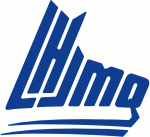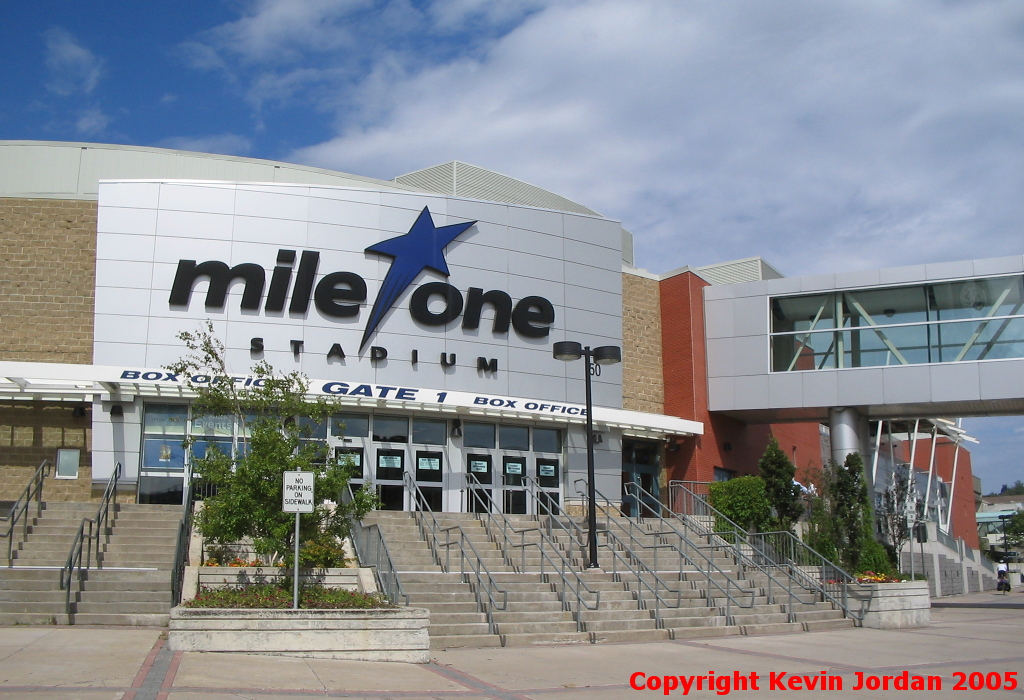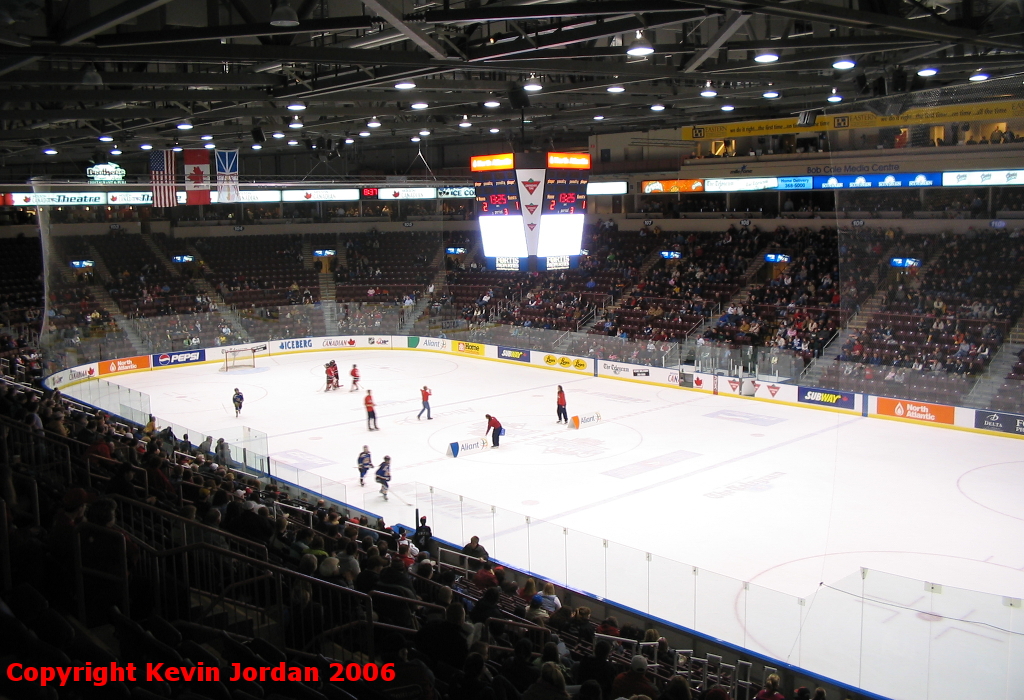
Newfoundland Regiment
Arena Name: Mary Brown's Centre
Capacity: 6,250
Built: 2001
Address: 50 New Gower Street, St. John's, NL, A1C 1J3
Telephone No: (709) 758-1111
Ice Surface Size: Regulation
Franchise Date: 2025-26
QMJHL Championships: None
Memorial Cup Championships: None
Colours: Puttee Blue, Maroon, Tan and White
Official Web Site: NLRegiment.com
Venue Web Site: MBCentre.ca

Mary Brown's Centre

What's the Arena Like?
First Visit: September 23, 2005
CHL Arena: 24
QMJHL Arena: 2
I have a distinct memory of discussing the concept of "home" with a new friend and classmate called Alix in the autumn of 2005. After spending my entire life to that point living in London, Ontario (and all but one of those years within the same neighbourhood), as of that fall I was now a resident of St. John's and a new graduate student at the Memorial University of Newfoundland. My idea of home at that time was centred on the place where I was born and grew up, but Alix, a fellow Ontario native who'd lived in multiple different places over the course of her life, insisted that it was possible to have more than one place that felt like home; that it was possible to be homesick even while living in a place that felt like home.
Naturally I didn't fully appreciate it at the start of the year, but over the course of a little more than a year living in Newfoundland, St. John's became my home just as surely as if I'd grown up there. I learned to navigate a new city, one with many steep hills and confounding streets which changed their names multiple times over the course of a kilometre. I developed an opinion on whether Ches's or Leo's had the better fish n' chips (with gravy and dressing, of course). I discovered how to walk with my body angled into the ever-present wind, and to appreciate a fine weather day as a divine gift that might not be repeated for weeks. I learned to cook jiggs dinner and fish and brewis and developed a taste for birch beer. I learned to anticipate people guessing I was from the Southern Shore or Harbour Grace based solely upon my Irish surname, and then to apologetically disappoint them by saying I was from The Mainland. I went for pints at the Duke of Duckworth and had White Russians at Lottie's. I hiked around the North Head and climbed Mount Scio and Signal Hill and the Southside Hills. I got into the best shape of my life, given how restricted I was in getting around only by biking and walking, thanks to not being able to afford a car and by how terrible Metrobus service was. (Could I ride my bike straight up the Hill O'Chips or Long's Hill without stopping? Reader, I could!)
I never got screeched in, either - that was for tourists, and I was a local now. I even unexpectedly developed a slight Newfoundland accent that now lies dormant in Ontario but involuntarily emerges when in the company of other Newfoundlanders.
And then I finished and submitted my thesis and went home, back to Ontario, back to my family, back to the girlfriend that eventually became my wife, back to buy a house and start a career and do all the other things you do over the course of a lifetime. I left Newfoundland on the Port-aux-Basques ferry in September 2006 and didn't return for over nineteen years.
I didn't choose to move to St. John's because of the hockey, but it was a lovely coincidence for me that I was there for the birth of junior hockey in Newfoundland. 2004-05 was the greatest junior hockey season of my life, one in which I went to 66 of the 90 games my hometown London Knights played en route to their first Memorial Cup, and then in 2005-06 I started over with a new team and a new league. The St. John's Fog Devils were born out of the ashes of the Toronto Maple Leafs' decision to move their AHL affiliate from the Rock to the CNE. I was quite possibly the only seasoned junior hockey fan in the entire city at the beginning, enough so that the team's president Craig Dobbin, Jr. actually sought me out from the old internet message boards to pick my brain on how the fan experience compared to other places around the CHL. I went to 17 games that year at Mile One Stadium, one per homestand when I was in town, and to this day I can name a good chunk of that team's roster from memory (T.J. Brennan! Ilya Ejov! J-S Allard!)
But the Fog Devils were doomed from the beginning, both by the added expenses of operating in Newfoundland coupled with what I understood was the worst lease in the CHL, and they'd leave town two years after me, in 2008. In the interim, Mile One would be renamed from Stadium to Centre and then for local fried chicken joint Mary Brown's, the AHL would return and then leave again, and then the ECHL arrived and left. Then, twenty years on from the birth of the Fog Devils, the QMJHL was back in town, this time working with the city rather than against it, with a new team, moved from Bathurst, that would be called the Newfoundland Regiment. I took that as my cue. Enough time had passed. It was time for me to come home.
I saved my old Fog Devils review that this website had up for twenty years - I can't bring myself to delete that page forever, even if it's no longer public - but what struck me upon my return to the Mary Brown's Centre for hockey is how little has changed. The scoreboard was replaced as definition continues getting higher and higher, and the seats were all changed at one point, but otherwise the building is mostly the same as the one I remember. Moreover, the experience of going to a Regiment game isn't appreciably different from what the Fog Devils were. Newfoundland hockey fans aren't the loudest or most into the game, but they're friendly and passionate nonetheless, and with the exception of the uniforms on the ice and a few other changes, it felt pretty much exactly what I remembered.
So, to take care of the review stuff one would expect from me - the arena sits right downtown and is probably the best arena location in the entire CHL, a few blocks from the harbour and with an incredible selection for restaurants for pregame and pubs for postgame. There are parking garages nearby, but I never had a car in St. John's and would recommend that out-of-town visitors stay in one of the many hotels downtown and then walk to the game. The architecture is pretty standard turn-of-the-millennium yellow and red brick with silver cladding, attractive enough without being interesting.
Inside, it's a pretty typical early 2000's clone rink, with a single concourse below the seats and a single bowl inside, one level of about 6000 seats (maroon then, now navy blue) with suites behind them. The concourse was then, and still is, pretty barren, with a small team store and a war memorial near the main entrance being the only things that break up a bland, neutrally-painted area. The ceiling of the rink isn't level but rather slopes up to one side to accommodate the press box in the rafters, which is named for the greatest play-by-play guy in the history of hockey, local native Bob Cole.
There are small food concessions around the concourse with two larger ones along the sides, one of which is a bar and the other is a full-service Mary Brown's, which of course it is. The rink also has something I've never seen before, beer vending machines, but each one appeared to need a babysitter to make sure no one got served that shouldn't have, so I don't really see the point of that rather than a grab-and-go station.
I wouldn't have realized it at the time, but all St. John's teams prior to (and after) the Fog Devils occupy one continuum of ownership and management, which is part of why the Devils' lease was so bad at Mile One - if the city couldn't run the team, they wanted no part of it and didn't care if it was successful. But the Maple Leafs, IceCaps, Growlers and Regiment all share DNA, and as a result I learned a few things on this trip that I wouldn't have picked up on before. All the other St. John's teams shared a mascot - a puffin called Buddy - and the original Buddy was so beloved that when the guy who wore the costume passed away unexpectedly in 2022, the team elevated a portrait of him to a place above the seats in one end, a space where in other rinks you'd find a portrait of the Queen! Today's mascot is Buddy Jr, another puffin and supposedly Buddy's son.
Game presentation in St. John's is just fine, pretty nondescript by hockey terms. About the only thing that stood out to me was the playing of the Ode to Newfoundland before the game, sung and absolutely nailed by the same guy both games. Newfoundland was a self-governing Dominion between 1907 and 1949 - the same status then as New Zealand - and the Ode was her national anthem. Post-confederation Newfoundland lost her semi-independence, but the playing of the Ode still makes a huge amount of sense, in a way that playing A Place to Stand, A Place to Grow prior to a Kingston Frontenacs game wouldn't.
Outsiders sometimes look down upon St. John's having lost team after team over the years and assume that it's a fan thing, but it absolutely is not. The IceCaps had a sellout streak several years long, the Baby Leafs were always well-supported, and even the Fog Devils were seventh of eighteen in QMJHL attendance all three years they played at Mile One. It is not and never has been about bums in seats, but rather about the isolation and logistics of paying to fly in all the visiting teams. But I sincerely hope that the Regiment can finally lock in long-term and be successful. St. John's is a great hockey town, it's just unfortunately the one market in North America where good attendance and local support isn't always enough.
I noticed walking around St. John's over the weekend that I was in town again that a number of cars on the road sported license plates with a different slogan on them - these plates simply read "Come Home." Seeing that locked in my takeaway from the weekend - that Alix was right. St. John's was my home for a year, and it always will be on some level. Wandering around town with my wife and Steve McLean, it struck me how many things had remained the same despite many inevitable changes. I still knew my way around, still knew which restaurants and pubs to go to, still had a local's instinctive feel for how the city moves and breathes on a daily basis. Living where I do now, less than a mile from the hospital in London where I was born, I hadn't realized how homesick I was. I genuinely do believe that the Regiment will be successful this time, but regardless, it won't be another twenty years before I come home again.
Inside Mary Brown's Centre

Future Developments
There are no plans to renovate or replace Mary Brown's Centre.
Franchise History
The Regiment franchise was one of the founding members of the QMJHL, playing in 1969-70 in the Montreal borough of Rosemont at Paul Sauvé Arena as the Rosemont National. However that did not last long, and in 1971 they moved a few kilometres north to the Colisée de Laval, where they would become one of the Q's cornerstone franchises, winning four league titles under the names of Laval Voisins (Neighbours) and Laval Titan. The team produced several legendary hockey players during their time at the Colisée, including Hall of Famers Mario Lemieux and Mike Bossy. However, the team ran into attendance problems in the mid 1990's, and decamped to the heart of Acadia in 1998, playing at the K.C. Irving Regional Centre. Perennial low attendance in the CHL's smallest market doomed the team there in the wake of the COVID-19 pandemic, and they moved to St. John's for the start of the 2025-26 season.
This is the second QMJHL franchise to call the building home. The original, my beloved Fog Devils, are now the Blainville-Boisbriand Armada.
This is the second QMJHL franchise to call the building home. The original, my beloved Fog Devils, are now the Blainville-Boisbriand Armada.
Retired Numbers
None
Feedback
If anything is incorrect or you have something to add, please e-mail me at  and I'll update the guide.
and I'll update the guide.
 and I'll update the guide.
and I'll update the guide.Copyright © QMJHL Arena Guide, 2002-25.
All rights reserved.
Last Revised: November 11, 2025